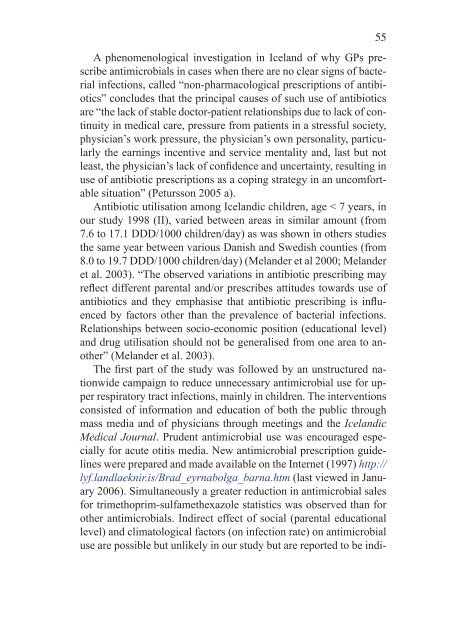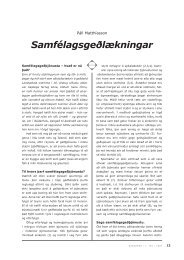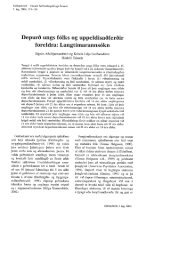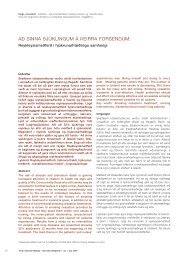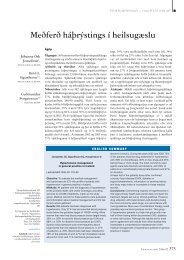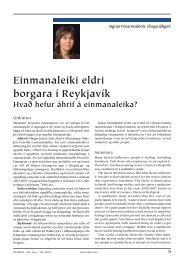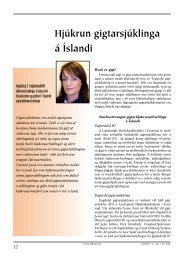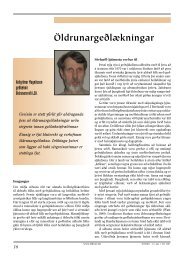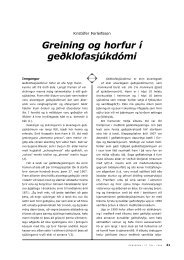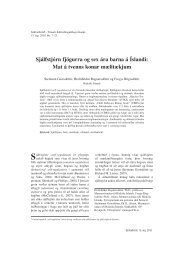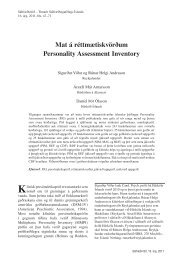Use of antimicrobials and carriage of penicillin-resistant ... - Hirsla
Use of antimicrobials and carriage of penicillin-resistant ... - Hirsla
Use of antimicrobials and carriage of penicillin-resistant ... - Hirsla
You also want an ePaper? Increase the reach of your titles
YUMPU automatically turns print PDFs into web optimized ePapers that Google loves.
A phenomenological investigation in Icel<strong>and</strong> <strong>of</strong> why GPs prescribe<strong>antimicrobials</strong> in cases when there are no clear signs <strong>of</strong> bacterialinfections, called “non-pharmacological prescriptions <strong>of</strong> antibiotics”concludes that the principal causes <strong>of</strong> such use <strong>of</strong> antibioticsare “the lack <strong>of</strong> stable doctor-patient relationships due to lack <strong>of</strong> continuityin medical care, pressure from patients in a stressful society,physician’s work pressure, the physician’s own personality, particularlythe earnings incentive <strong>and</strong> service mentality <strong>and</strong>, last but notleast, the physician’s lack <strong>of</strong> confidence <strong>and</strong> uncertainty, resulting inuse <strong>of</strong> antibiotic prescriptions as a coping strategy in an uncomfortablesituation” (Petursson 2005 a).Antibiotic utilisation among Icel<strong>and</strong>ic children, age < 7 years, inour study 1998 (II), varied between areas in similar amount (from7.6 to 17.1 DDD/1000 children/day) as was shown in others studiesthe same year between various Danish <strong>and</strong> Swedish counties (from8.0 to 19.7 DDD/1000 children/day) (Mel<strong>and</strong>er et al 2000; Mel<strong>and</strong>eret al. 2003). “The observed variations in antibiotic prescribing mayreflect different parental <strong>and</strong>/or prescribes attitudes towards use <strong>of</strong>antibiotics <strong>and</strong> they emphasise that antibiotic prescribing is influencedby factors other than the prevalence <strong>of</strong> bacterial infections.Relationships between socio-economic position (educational level)<strong>and</strong> drug utilisation should not be generalised from one area to another”(Mel<strong>and</strong>er et al. 2003).The first part <strong>of</strong> the study was followed by an unstructured nationwidecampaign to reduce unnecessary antimicrobial use for upperrespiratory tract infections, mainly in children. The interventionsconsisted <strong>of</strong> information <strong>and</strong> education <strong>of</strong> both the public throughmass media <strong>and</strong> <strong>of</strong> physicians through meetings <strong>and</strong> the Icel<strong>and</strong>icMedical Journal. Prudent antimicrobial use was encouraged especiallyfor acute otitis media. New antimicrobial prescription guidelineswere prepared <strong>and</strong> made available on the Internet (1997) http://lyf.l<strong>and</strong>laeknir.is/Brad_eyrnabolga_barna.htm (last viewed in January2006). Simultaneously a greater reduction in antimicrobial salesfor trimethoprim-sulfamethexazole statistics was observed than forother <strong>antimicrobials</strong>. Indirect effect <strong>of</strong> social (parental educationallevel) <strong>and</strong> climatological factors (on infection rate) on antimicrobialuse are possible but unlikely in our study but are reported to be indi-55


